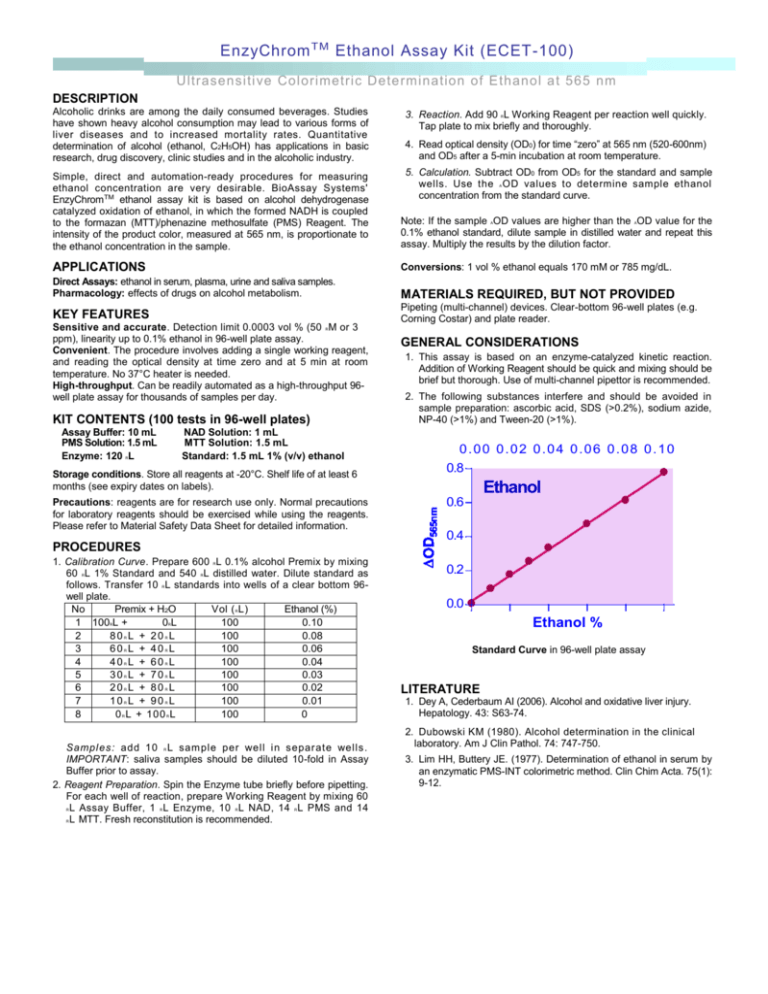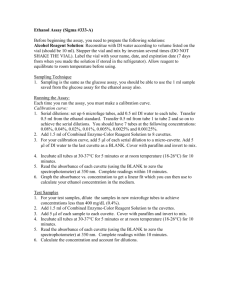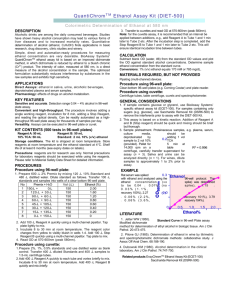EnzyChrom™ Ethanol Assay Kit
advertisement

EnzyChrom TM Ethanol Assay Kit (ECET-100) Ultrasensiti ve Colorimetric Dete rmination of Ethanol a t 565 nm DESCRIPTION Alcoholic drinks are among the daily consumed beverages. Studies have shown heavy alcohol consumption may lead to various forms of liver diseases and to increased mortality rates. Quantitative determination of alcohol (ethanol, C2H5OH) has applications in basic research, drug discovery, clinic studies and in the alcoholic industry. 3. Reaction. Add 90 L Working Reagent per reaction well quickly. Tap plate to mix briefly and thoroughly. Simple, direct and automation-ready procedures for measuring ethanol concentration are very desirable. BioAssay Systems' EnzyChromTM ethanol assay kit is based on alcohol dehydrogenase catalyzed oxidation of ethanol, in which the formed NADH is coupled to the formazan (MTT)/phenazine methosulfate (PMS) Reagent. The intensity of the product color, measured at 565 nm, is proportionate to the ethanol concentration in the sample. 5. Calculation. Subtract OD0 from OD5 for the standard and sample wells. Use the OD values to determine sample ethanol concentration from the standard curve. Note: If the sample OD values are higher than the OD value for the 0.1% ethanol standard, dilute sample in distilled water and repeat this assay. Multiply the results by the dilution factor. APPLICATIONS Conversions: 1 vol % ethanol equals 170 mM or 785 mg/dL. Direct Assays: ethanol in serum, plasma, urine and saliva samples. Pharmacology: effects of drugs on alcohol metabolism. MATERIALS REQUIRED, BUT NOT PROVIDED KEY FEATURES Pipeting (multi-channel) devices. Clear-bottom 96-well plates (e.g. Corning Costar) and plate reader. Sensitive and accurate. Detection limit 0.0003 vol % (50 M or 3 ppm), linearity up to 0.1% ethanol in 96-well plate assay. Convenient. The procedure involves adding a single working reagent, and reading the optical density at time zero and at 5 min at room temperature. No 37°C heater is needed. High-throughput. Can be readily automated as a high-throughput 96well plate assay for thousands of samples per day. R 4. Read optical density (OD0) for time “zero” at 565 nm (520-600nm) and OD5 after a 5-min incubation at room temperature. A A A R KIT CONTENTS (100 tests in 96-well plates) Assay Buffer: 10 mL PMS Solution: 1.5 mL Enzyme: 120 L NAD Solution: 1 mL MTT Solution: 1.5 mL Standard: 1.5 mL 1% (v/v) ethanol R Storage conditions. Store all reagents at -20°C. Shelf life of at least 6 months (see expiry dates on labels). Precautions: reagents are for research use only. Normal precautions for laboratory reagents should be exercised while using the reagents. Please refer to Material Safety Data Sheet for detailed information. PROCEDURES 1. Calibration Curve. Prepare 600 L 0.1% alcohol Premix by mixing 60 L 1% Standard and 540 L distilled water. Dilute standard as follows. Transfer 10 L standards into wells of a clear bottom 96well plate. No Premix + H2O Vol ( L) Ethanol (%) 1 100 L + 0L 100 0.10 2 80 L + 20 L 100 0.08 3 60 L + 40 L 100 0.06 4 40 L + 60 L 100 0.04 5 30 L + 70 L 100 0.03 6 20 L + 80 L 100 0.02 7 10 L + 90 L 100 0.01 8 0 L + 100 L 100 0 R R R GENERAL CONSIDERATIONS 1. This assay is based on an enzyme-catalyzed kinetic reaction. Addition of Working Reagent should be quick and mixing should be brief but thorough. Use of multi-channel pipettor is recommended. 2. The following substances interfere and should be avoided in sample preparation: ascorbic acid, SDS (>0.2%), sodium azide, NP-40 (>1%) and Tween-20 (>1%). 0.00 0.02 0.04 0.06 0.08 0.10 0.8 Ethanol 0.6 0.4 0.2 R R R R R R R R R R R R R R R R R Sampl es: add 10 L sam ple per well i n separate wells. IMPORTANT: saliva samples should be diluted 10-fold in Assay Buffer prior to assay. 2. Reagent Preparation. Spin the Enzyme tube briefly before pipetting. For each well of reaction, prepare Working Reagent by mixing 60 L Assay Buffer, 1 L Enzyme, 10 L NAD, 14 L PMS and 14 L MTT. Fresh reconstitution is recommended. R R R 0.0 Ethanol % R R R R Standard Curve in 96-well plate assay LITERATURE 1. Dey A, Cederbaum AI (2006). Alcohol and oxidative liver injury. Hepatology. 43: S63-74. 2. Dubowski KM (1980). Alcohol determination in the clinical laboratory. Am J Clin Pathol. 74: 747-750. 3. Lim HH, Buttery JE. (1977). Determination of ethanol in serum by an enzymatic PMS-INT colorimetric method. Clin Chim Acta. 75(1): 9-12.







